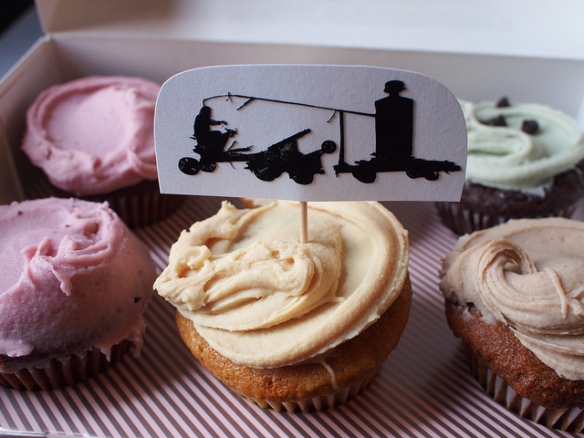ON Chris Hackett’s personal periodic table, the world’s most interesting, and abundant, substance is an element he calls obtainium. Things classified as obtainium might include the discarded teapot that he once turned into a propane burner, or the broken beer bottle he used to make a razor, or the 9-millimeter shell casings he acquired some time ago, melted in a backyard foundry (also made of obtainium) and cast into brass knuckles for a girlfriend.
If you ask Mr. Hackett — or Hackett, as he is uniformly known in the Brooklyn bohemia that skips south, from the G station at Greenpoint Avenue to the Gowanus Canal — where he got the components for his homemade still or the numerous jet engines he has built from scratch, he will likely shrug, smile and say, “Around.”
Last month, Mr. Hackett, 39, was working in his Gowanus workshop, a ground-floor space on Butler Street, near the head of the canal. The workshop is a veritable obtainium mine. In one corner sat an upright piano transformed into a cabinet for fasteners. In another was a rack of reclaimed two-inch metal tubing. There were doctored band saws, jury-rigged drill presses, repurposed metal barrels. A shop cat, Shop Cat, napped in front of a plastic chest of drawers marked with labels reading, “ball bearings,” “flange bearings,” “regulators,” “pulleys,” “rivets,” “channel locks,” “drills” and “more drills.” The backyard was heaped with obtainium: half of a car’s rear axle, bolted I-beams, a yellow boat built from scrap.
Stuck with Hackett episodes now available on Amazon Prime video
Today Amazon announced a big deal with Discovery networks to get their content on Amazon Prime instant video– this includes all sorts of shows like Mythbusters, Deadliest Catch, and naturally, Stuck with Hackett! Watch season 1 now. Of course there are no residuals coming from iTunes or Amazon, but as show/episode ideas get tossed around between the higher ups at Science, no views are bad views.
Do Bears…? Homemade Bathroom

Do Bears…?
9/29 at 10:30PM e/p
Hackett finds himself at an abandoned RV camp in the middle of the woods. The camper lacks indoor plumbing, a modern convenience he refuses to live without. He sets out to build a bathroom and shower from the discarded items of the campsite. Needing to get water from the ground up into a tree, Hackett creates a bicycle-powered “sponge brigade” pulley system to bring him closer to his goal of a working flush toilet. Using plastic water bottles as pipes, and a plastic pink flamingo as a showerhead, Hackett is well on his way to creating the thing he’s most looking forward to at the end of a hard day: a steaming hot shower. That’s when things get complicated. Unable to heat water in the way he intends, Hackett has to improvise a way to bring the heat to the water, using rocks, a metal container, propane, and some good old-fashioned brute force.
I know this group of people, an ad-hoc art collective with members drawn from the usual places where people who are in ad-hoc art collectives hail from (Oakland, Brooklyn, New Orleans- actually, none of them are originally from Oakland, Brooklyn, or New Orleans, but this is where it starts to get tedious so I will leave it at that), who are working on a big, grand project in an abandoned building in Detroit. (I think it is telling that like seventy percent of the people that I know have a history of being involved in abandoned building-focused projects in Detroit, myself included. In the non-teevee world I live in, working on stuff in abandoned buildings in Detroit is about as edgy as wearing mismatched socks, but slightly less interesting.)
Anyway: this group of people are all young and attractive, some are even talented. Their project has promise, the place where they are staying has no plumbing. A dozen people, a month of close-quarters living, a hand-dug trench as a toilet. This skeeves me out in ways that are so deep and primal that articulating it is impossible: I am a guy who is never at a loss for words, and when I heard about what they were doing, all I could say was “Ewwww”.
On this week’s episode I am stuck at a trailer in the middle of some of the most gorgeous countryside I have ever been in, a landscape that looked exactly like the rolling terrain that is built around a really high-end model train set. The trailer is a classic Airstream, seemingly recently inhabited by hippies. I hate hippies. As usual, my rage was the source of comedy gold. As usual, the gold was cut out by the order of the network. They did not want to alienate the lucrative (getting up there in age, I assume) hippie demographic. Expect ads for tie-dyed adult diapers and hybrid SUVs. Also, there was a lot of ranting about carnivorous horses (don’t ask) that prob got cut out as well.

This episode contains what might be my favorite build of the season, the sponge brigade pump. Water is moved from a stream to a cistern using a conveyor belt of sponge foam threaded along a rope, driven by pedal power. I have never, ever seen a system like this, and it worked wonderfully. I would like nothing more than to take credit for this brilliant hack, but Chuck Messer, producer, engineer, and owner of Lena (the smartest dog in the world), came up with it.
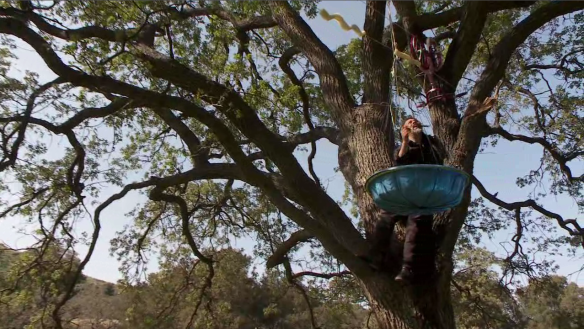
Also: I spent a lot of time in trees. There might or might not be a risque shower scene at the end, depending on if I was too sexy for the censors.
Stuck With Hackett on the Science Channel
Watch clips from Stuck With Hackett on YouTube
Really Freaking Fast Food
The second of two-in-a-row episodes. This was the last one we shot. I abuse a machine shop to make fast food, Hackett-style.

Rage is my primary source of creative energy- when it comes to building art, writing, or ranting on the teevee. (This is the main reason why I do not smoke pot- it dulls my hate. Also, it would make hippies think we have something in common.). I hate consumerism. I hate cheap crap in all of its forms. I hate fast food.
As a result, this episode should be comedy gold. There are a couple of cool builds here- thermite for cooking, a french-fry machine made from a potato gun and a hot water heater- and I hurt myself, pretty badly, with a plasma torch. Like I said, comedy gold.
Really Freaking Fast Food
9/22 at 10:30PM e/p
Using discarded food from a Grocery Store dumpster, and a fully equipped machine shop, Hackett attempts to make his own fast food empire. Unable to use a conventional kitchen, Hackett has no choice but to use machine shop tools to prep and cook his fast food. To industrialize the French Fry making process, he uses an oversized potato cannon and a hot water heater. Without a heat source to cook his burgers, Hackett is forced to turn to science. Using an unconventional recipe of rust and metal, Hackett creates a 5000-degree fire to cook his burgers. All of this industrialization equates to one thing, a Hackett Burger Value Meal.
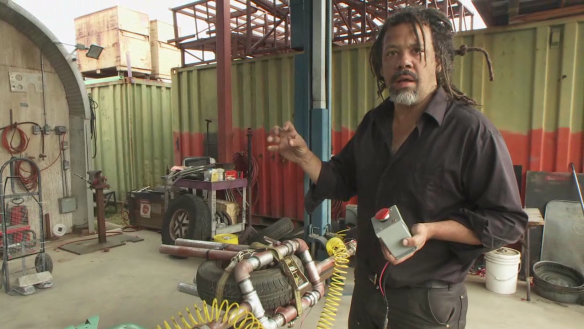

Dirt Boat: Sail the Land
In an effort to see who, exactly is into the show, and how to get more of them to watch it the Science Channel is tweaking the scheduling no Stuck with Hackett last week, a double dose this week. The first episode has me making a dirt boat- a land sailer- apparently, “Dirt Boat” is the preferred term, at least, that is what I was told by Dennis, the king of all Dirt Boaters, a super knowledgeable, charming, hard-working guy who consulted on this episode. It could be that no one calls then “Dirt Boats” except for him, and now, to his delight at a very well-played practical joke and the horror of the land sailing community, the whole non-dirt-boating world.
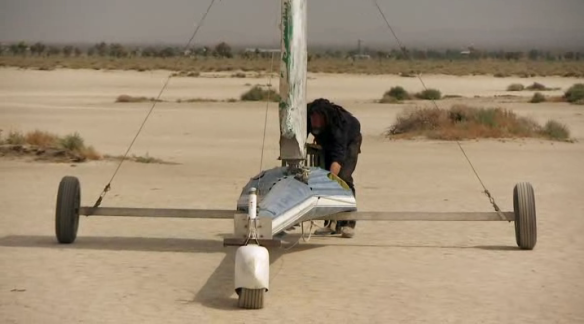
The final result, while cool, kind of pales in comparison to the setting and a couple of the intermediate builds. The setting was an airplane junkyard- not the big ones you have seen in movies etc (I have seen one of those too- out in the Mojave Desert, miles and miles of parked airplanes stretching to the horizon, like the toy collection of a god with OCD or some kind of convoluted metaphor about the decline of American power) but still pretty vast, seeing how it is full of AIRPLANES, which are not small things. The junkyard was only ordered-ish, with some parts (hydraulic cylinders, airplane bathrooms) well ordered, and other piles of casually stacked airplanes.
I was excited and happy in the railroad junkyard where we filmed EP1. Railroad obtainium is pretty neat, but is gross, oversized garbage compared to airplane junk. Airplane parts are some of the best-looking, most finely engineered stuff in the world. The parts and the whole need to be reliable, strong, able to withstand horrific conditions that nothing on the ground will ever experience, unless it is in the moment of a catastrophic accident, and then, after all that, the thing needs to FLY. Think about that. See your car, your bike, hell, even your fancy pocket computer? Imagine that the well-honed piece of machinery you are holding or looking at can do all that it does, but in the -59 degree cold and 500 mile an hour windchill, with no oxygen, and STILL FLY. Even the rattiest, most tore-up airplane parts are more finely engineered than anything you will ever run into in everyday life. As a font of obtainium it was heaven.
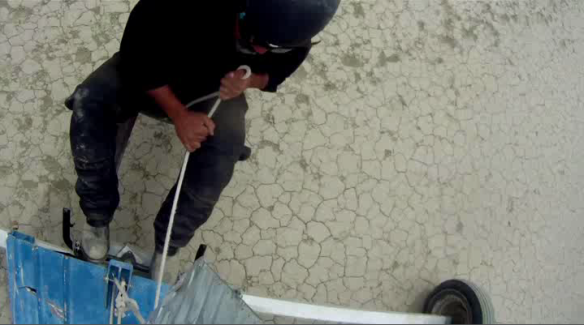
One great thing about doing this show is that I get to build stuff from my List (you know- the grand, sprawling, always growing, never ended list of cool shit you want to build or learn or do). On this episode I make a waste oil furnace, a really clever, simple way of turning waste oil (like, from oil changes) into useful heat. In this case, I use it to fire a foundry and melt metal to cast a part. Additionally, there are some interesting bits about mechanical advantage and pulleys, and a bit about fluid dynamics. Hope the science made it into the edit. I also got to move heavy shit by myself and rail against the seedy world of modern aviation, a reference that I think only Julia will get.
Dirt Boat
9/22 at 10PM e/p
Hackett finds himself at an aviation junkyard stocked with old planes. Unfortunately, he hates air travel: the noise, the service, the fatal crashing. Fortunately, the junkyard hangs on the edge of a dry lakebed, the perfect place for another, more Hackett-friendly mode of transportation: a dirt boat that will sail the land at dangerously high speed, using wheels instead of water.
Stuck With Hackett YouTube Playlist




Maker Faire New York
This past weekend was Maker Faire, a regular, traveling celebration of different types of nerd. Maker Faire has been happening for a few years now, starting as a Bay Area thing five or six years ago. This was the second annual New York City iteration. Last year was far, far more interesting. Why?
Well, last year there was this:
and this:
By default, Maker Faire is “Family Friendly”, kind of a G-rated event, child safe in a way that tends toward all-edges-sanded-off and dull; going counter to the “violate your warranty” ethos of Make Magazine, but prob making their lawyers a lot happier.
Safety Third! cried the Madagascar Institute, and we added in a little sex, a little violence, while keeping it at a solid PG, maybe PG-13 (depending on Sarah Mac’s top). This year, we were barely asked back, too little and too late, and the event suffered for it.
Anyway, my ego knows no bounds, so I did show up and met fans of the show:

Pretty sure I met all of them, all twenty or so. Photos were taken, hands were shook, one autograph was signed.
Also, I gave a talk on Teevee stardom as a means to an end for Makers:

The Suburbs Are for Suckers: Off-Grid Power Generation
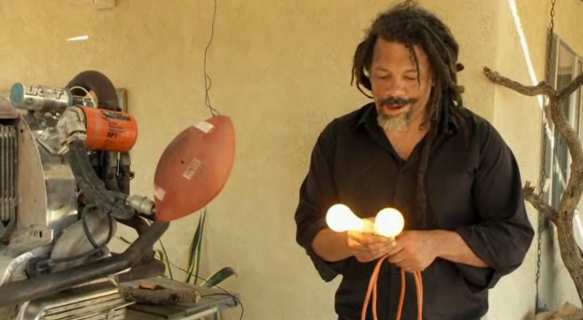
9/8 at 10:30PM e/p
Hackett is at an abandoned suburban house in the middle of the desert. The house has a $4000 a day electric bill, which Hackett finds completely unacceptable. Rather than paying such outrageous prices, he’s going to make his own power. Hackett takes the house “off the grid” — cutting it off from its electrical power source. Hackett wants to enjoy all the modern conveniences of suburbia, but now he has to generate power on his own. He starts with DC power, making a chemical battery that he hopes will give him enough juice to turn on the TV. When the battery fails to provide the power he needs, he goes to the next level, fashioning a windmill out of PVC pipe, a treadmill motor, and bits of obtanium. When windpower still doesn’t do the job, Hackett discards DC power in favor of the much more powerful alternating current (AC), which powers all appliances that connect into wall sockets; it’s the lifeline of suburbia, and Hackett is desperate for a piece of the suburban dream. Combining an old car engine with the motor from a table saw, Hackett hopes that AC power will give him what he wants most: TV.
New episode on the air (wait- what term does one use for the dissemination of a television show over cable? “Air”? No, it does not go through the air. “Broadcast”? No, it will be cast in a tight, controlled, only-to-cable-customers-who-opted-for-the-package-with-the-Science-Channel way, not in the old-school, available-to-anyone-with-rabbit-ears-on-top-of-a-monochromatic-Zenith kind of way. Drops? Too hip. Goes out? Yeah, that works.)
New episode goes out tomorrow (or today. Depends on when you are reading this. Sigh.)
New episode goes out Thursday, September 8th, 10:30pm Eastern time. Anyway. Here are some photos and video clips of Episode Four. Enjoy:
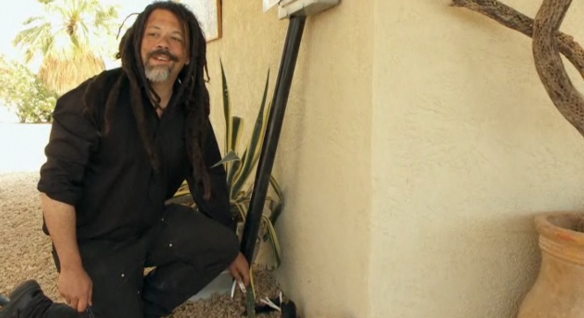
In this one, I make electricity, using obtainium to create electric power via chemical and mechanical means. This has been an interest of mine for a while- I have sitting in my shop an induction generator made from an old air compressor motor and a lawnmower engine; I have taught workshops in Canadia on converting obtainium (E-Waste: Junked, outmoded printers and scanners- dig into them, and you will find a trove of super-well engineered stepper motors that can generate clean, rectifiable AC, spun by wind turbines made from PVC pipe and soda bottles) into off-grid, low-or-no-cost cell phone chargers; and taught a class at NYU that dealt with generating, storing, and using purpose-generated power. Also, there are prob a half-dozen still-incomplete art pieces that utilize small-scale power generation within twelve feet of me as I type this.
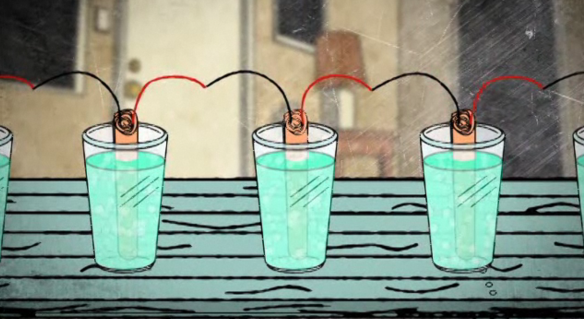
Personally, I think generating electricity from obtainium will be the linchpin of maintaining a nice standard of living while the world around you descends into the chaotic maw of a zombie/religious/political/metaphorical/not-at-all Apocalypse. Even if that never comes to pass, it is good stuff to know.

Your life depends on electricity. It is vital that you know what it is, how it works, and how to make some if all else fails.

I am curious and more than a little anxious, waiting to see how much information made it through the edit and into the 21 minutes of final form.
I trust it will be a good episode (I almost die! A couple of times! ) but if you want a nice little tidbit of interesting information, chew on this:
An amp is 6.241×10^18 electrons, passing a given point per second. The fact that with a little simple math you can figure out how many of the smallest real things in the universe it takes to run your toaster delights me to no end.
Build Your Own Welder with Car Batteries

This article originally posted on MAKE
Welding! Welding is a glorious, mystery-infused, thoroughly bad-ass way to stick things together. Welders move in their own cloud of mythos and danger – they are dirtier, tougher, and sexier than other kinds of makers, and the things they build are big and strong and hold our world together. This positive stereotype permeates at all levels of pop culture: if a character is introduced while welding, you immediately know that they will be some kind of blue-collar superhero, or some kind of cliched contradiction – the welder quoting Hegel after winning the bar fight, or the classic trope of seeing a welder at work, and then, they flip off their helmet, and OMG IT’S A GIRL! A GIRL WELDING! Want to be a welder but have no money and less experience? This guide to car battery welding on Make: Projects will help.
Who doesn’t want to get in on this skill set? Soldering makes electronic magic happen, knitting keeps you warm, but knowing how to weld will make attractive people of whatever orientation you are into swoon. Everyone wants to know how to weld. The biggest problem, for most people, is that you need access to a welding machine.
There are a few options here: you can borrow someone’s welding rig. I suppose welders are common on farms, but only 2% of Americans live on farms, and if you are one of them, you were probably out welding the cows and milking the corn within minutes of birth (I have only a vague idea of what goes on at farms, as you can see. Something with dirt, right?) If you live in the grittier, more industrial parts of cities, there are welding shops all over the place, but they are dark, scary places (part of their appeal) and if you were to walk into one, expecting to find dedicated tradesman open to the DIY spirit and eager to teach a snot-nosed kid, you will quickly discover that welders are dark, scary, busy people, bribe-able with beer, maybe, but not usually interested, at all, in teaching.
You can buy a welder. You can pick up a cheap 110v stick welder for about a hundred bucks (check big hardware stores, Amazon, or Craigslist) or a bare-bones, break-in-a-couple-of-hours MIG (wire feed) machine for under $150 (just saw some for that much, and lower, on Amazon. Do not buy them. They are garbage), but I know that many, many people cannot even afford that.
Also, if you are not sure about the whole welding thing and want to try it out, or just need to do a day of welding to finish that one big project, or need to repair things every now and then, buying a new piece of equipment is probably not the best course of action, especially since when it comes to welders (as it is with pretty much everything else), you get what you pay for.
The final option, and best for the poor or non-committed-to-welding maker, is to build a welder. There are many ways to do this, ranging from impressive feats of DIY electrical engineering all the way down to the easiest, simplest one: wiring together some car batteries (as seen in the “Laundromat of the Gods” episode). It is quick and uses stuff you either have lying around or can pretty easily obtain. Follow the instructions, and you can go from zero to welding in under an hour.
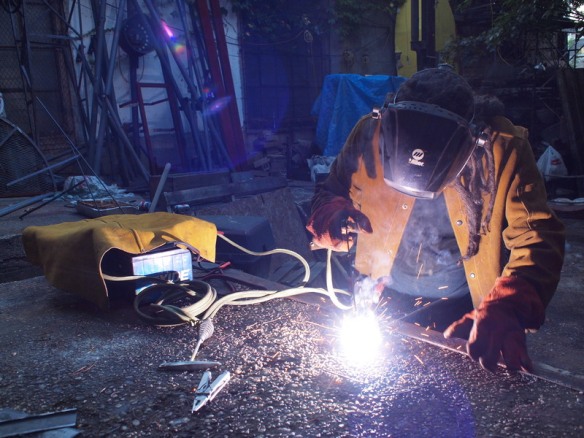
Caveats, cautions, and all that
Welding is dangerous! Even if you take every possible safety precaution, you will occasionally burn and cut yourself, and electric shocks and retinal burns are very common, even if you know what you’re doing — and you probably do not. Skimp on safety and you can blind yourself, suffer injuries that will make hardened ER doctors puke, and die in any number of closed-casket ways. When you’re starting out, wear a good, rated helmet, thick gloves, non-flammable natural fiber clothing (as much leather as possible), and boots. Later, when you have a couple of hundred hours of welding experience and the scar tissue has rendered you insensitive to pain (and pleasure — a downside of welding), you can do the weld in a T-shirt or gloveless bit, but at that point, you will know what you’re getting into (and trust me — UV-burned armpits suck).
One important bit of information that other welding tutorials leave out: At first, you will be horrible at this. There is a good chance you will not even be able to strike an arc, or if you do, you will not be able to maintain one. Or, if you can maintain one, you will burn through the things you are trying to weld or not really weld them at all. People tend to not document their failures online, and it is easy for the person who’s new at welding (or skateboarding, or juggling, or pretty much anything) to forget that the thing they are trying to learn is hard, and that the flaw is not in the instructor, but in the student. The flaw is in the student, but not in the way that you might think — remember that worthwhile things are hard and people do not document their learning curve or all of their countless failures. You will fail, but just keep trying and you will eventually get it right. It will just likely take longer than you think.
Lastly, welding is really not the be-all/end-all panacea for fabrication. It is difficult to do on anything except for steel, welded things are hard to take apart, and the heat tends to distort small or thin parts.
Hospital of Horror airs tonight!
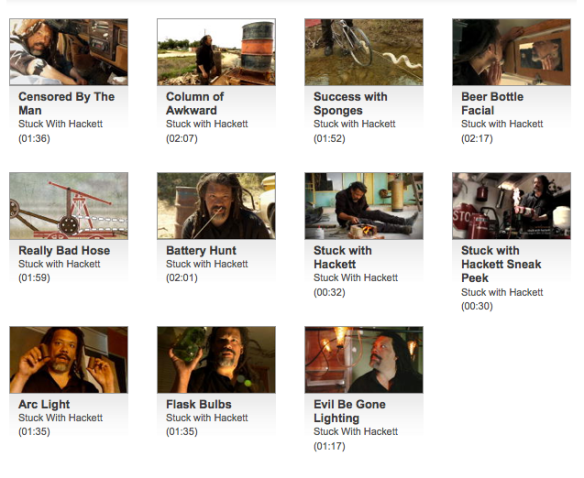
Episode 3: Hospital of Horror
9/1 at 10:30PM e/p
Hackett’s quest for fresh obtainium leads him to a disturbing place: a dark, abandoned hospital that’s so creepy, it must be haunted. As the sun dips low in the sky, the challenge of defeating darkness spurs him to build his own electric light out of the wreckage of the condemned building.Hackett’s first attempt is a primordial version of modern lights: a carbon arc lamp. To build it, he digs through toxic battery acid and nearly electrocutes himself… only to find that he’s built a lamp so dangerous, it’s more terrifying than the dark corridors themselves. A second attempt yields success as he takes on Thomas Edison to build a mad-scientist version of the modern light bulb. Having dominated the shadowy darkness of the abandoned hospital, Hackett decides to create his brightest light yet. He build a super-hot torch that runs on split water molecules to create dazzling, flesh-eating limelight… all to entertain himself with a found movie projector and some mysterious film reels.
Preview clips:
A new episode airs tonight. It was the only one shot in Los Angeles, in an abandoned hospital. “Abandoned” is probably more accurate the place shut down, under murky circumstances (I heard the exciting “high, unexplained death rate”, and the mundane, and most likely true “halls too narrow for modern gurneys” ) and was being used as a film locating probably later that day. It is a popular low-budget location, one that you have prob seen a dozen times in films and teevee shows. Years and years of artifice piled upon antiquing piled upon props- it was impossible to tell what was real and what was set dressing. For example: we shot a scene in the morgue, one of the producers getting freaked out and screaming like a little girl with a bee sting when one of the crew popped out from a body drawer. I was excited because, well, it is a morgue. I opened one body drawer, and went to open the one next to it (to see if there was internal access from one to another, or if there were any stray body parts jammed in the hinges) and discovered that the next door opened up onto a wall of stainless steel. It was all set dressing from who-knows-what forgotten film. We all felt kind of cheated, as if our honest excitement and emotion was retroactively false. I suppose there is a larger metaphor about teevee in general here, but I will leave it at that.
Anyway.
There were some awesome, super-clever builds on this one. The oxy-hydrogen torch was one of my favorites, and the carbon arc light looked so awesome that it was like watching another, much-higher-budget show.
Watch it, and let me know what you think.
Watching the people on teevee watch themselves
It was a kind of a meta night, with three people (me, and the stars of “JUNKies” :[horrible horrible name, or genius cross-marketing with soon-to-be-signed-methadone advertisers? Time will tell] Doyle in the “red” coverall [he is so huge he causes visible light to redshift due to his gravitational pull, making him look human-sized and the coverall look red], and next to him “Fire” I think is what she went by) who were all on teevee, but none of us own a teevee. I am sure that says something about something, but they just hire me for my looks (yeah. I know. We are talking really low budgets here). Many other skilled builders and potential future stars of basic cable were in attendance, about half of them visible in the below photo, all at the home of Super Awesome Nerd Queen Becky Stern, who made fancy cupcake toppers with her CNC vinyl cutter. She also took the photo.
I had not seen even a rough cut before this viewing, and anxiousness at possible revenge from the editors I never bothered learning the names of and treated rudely, at best, quickly evaporated. While I think the show felt a little rushed, and tons and tons of good stuff -rants, science, at least one whole build- did not make the cut (I hate and fear hobos, and had some great hobo jokes and rants, but the network ordered them all cut. Why? As not to offend hobos.Yes- you cannot alleviate that valuable, informed demographic of syphilis-ridden, teevee-less boxcar dwellers, who only get a new bindle when they shiv the previous owner as they sleep off a Sterno binge. Yeah. Don’t piss them off, or they will boycott the car companies advertising on the show and steal more cooling pies from the windowsills of America. I think the show should be an hour long. I also think I am a genius, but the people in the room with me also liked the show, and they are people who know me well enough to feel no need to blow smoke up my ass, people who would have eagerly mocked me if they thought the show sucked. If you liked it, make a comment. If you saw some serious flaws or have a question, let me know. Your criticisms might well be ignored or even derided, but that sort of interaction and user-generated content is supposed to matter in the world of today, so I will pretend to care.
Also: You should watch next week’s episode. It was fun to make, and involves improvised projectile weapons, power sporks, fire, one sweaty dude moving a huge thing by himself, and a possible answer to the problem of post-apocalyptic laundry.
Laundromat of the Gods
8/25 at 10:30PM e/p
Hackett is stuck in a place where modern technology comes to die: the junkyard. For Hackett, it’s the mother lode of obtainium. The only downside is that it’s also the world’s dirtiest place, it’s filled with a strange type of goo — a mixture of hemorrhaged engine gas bleeding from rusty tanks and the dust of 1,000 rotting cars — and it leaks all over his clothes. Since there is no way Hackett will pay thousands of dollars for an industrial washer/dryer, he sets out to make one. Hackett finds an old American clunker — this is the base structure for his washer and dryer system. To complete the transformation from car to washer/dryer, Hackett must build a welder from scratch, reinvent the spin cycle, and turn the exhaust fumes of a car into the heat he needs to dry his clothes.




